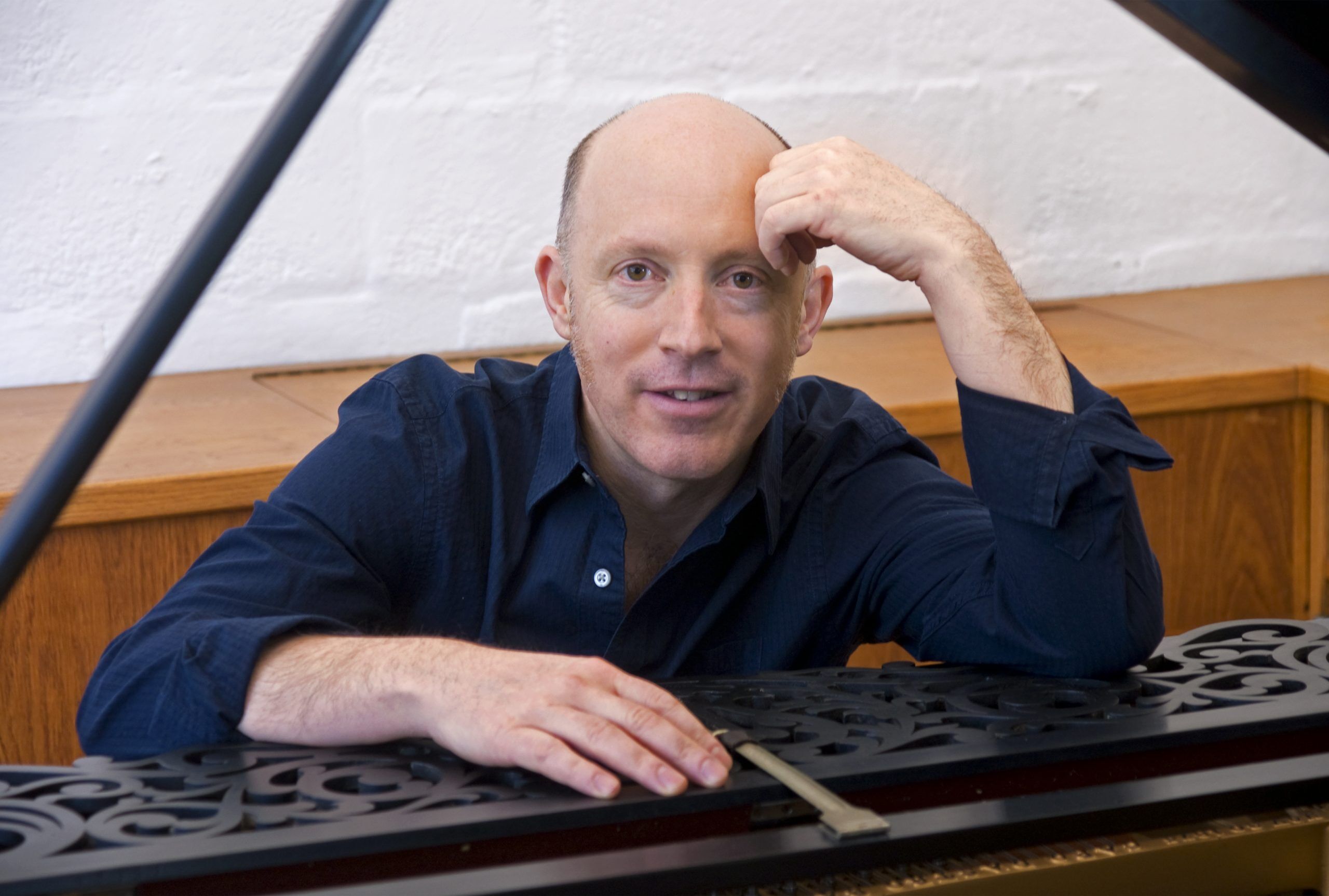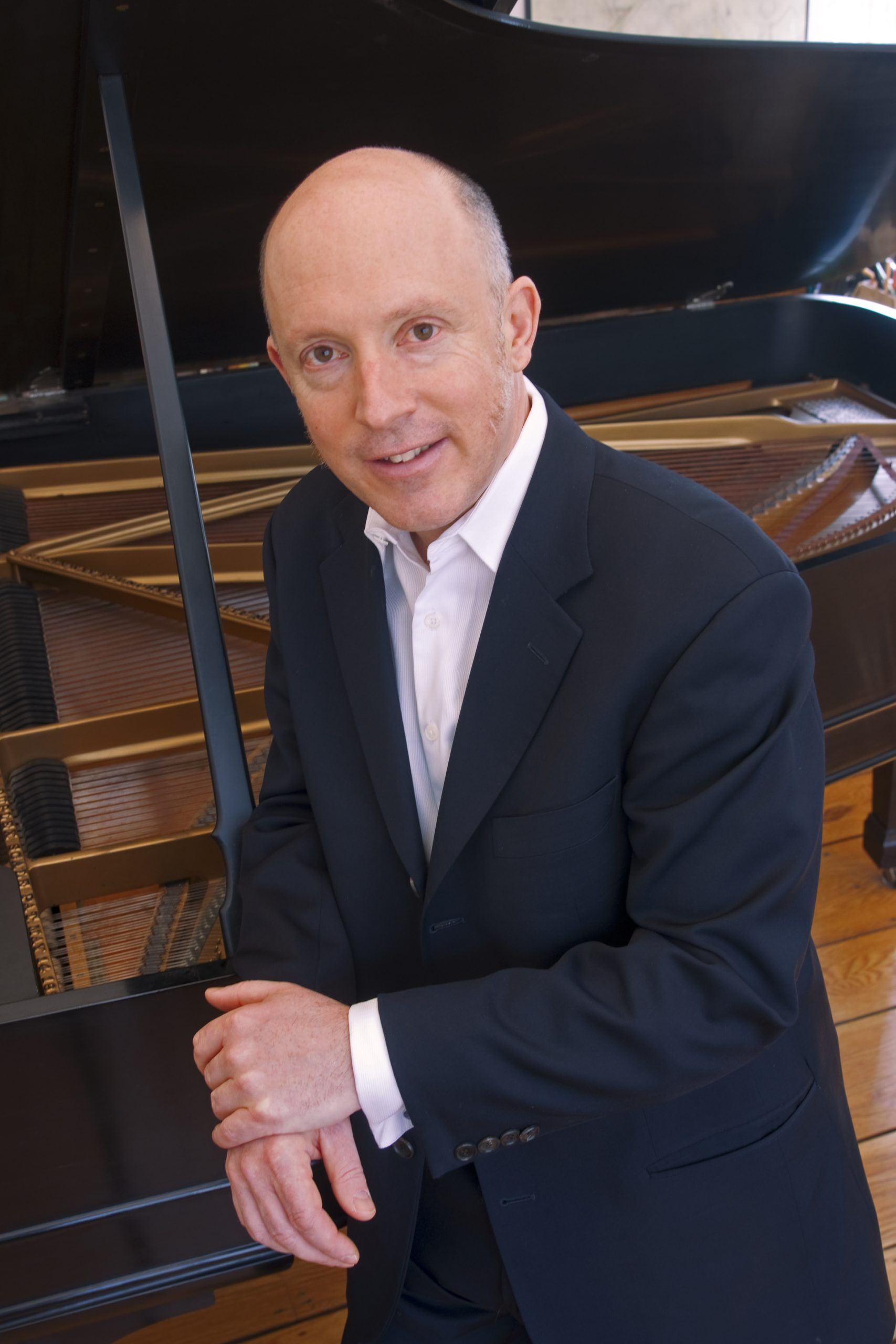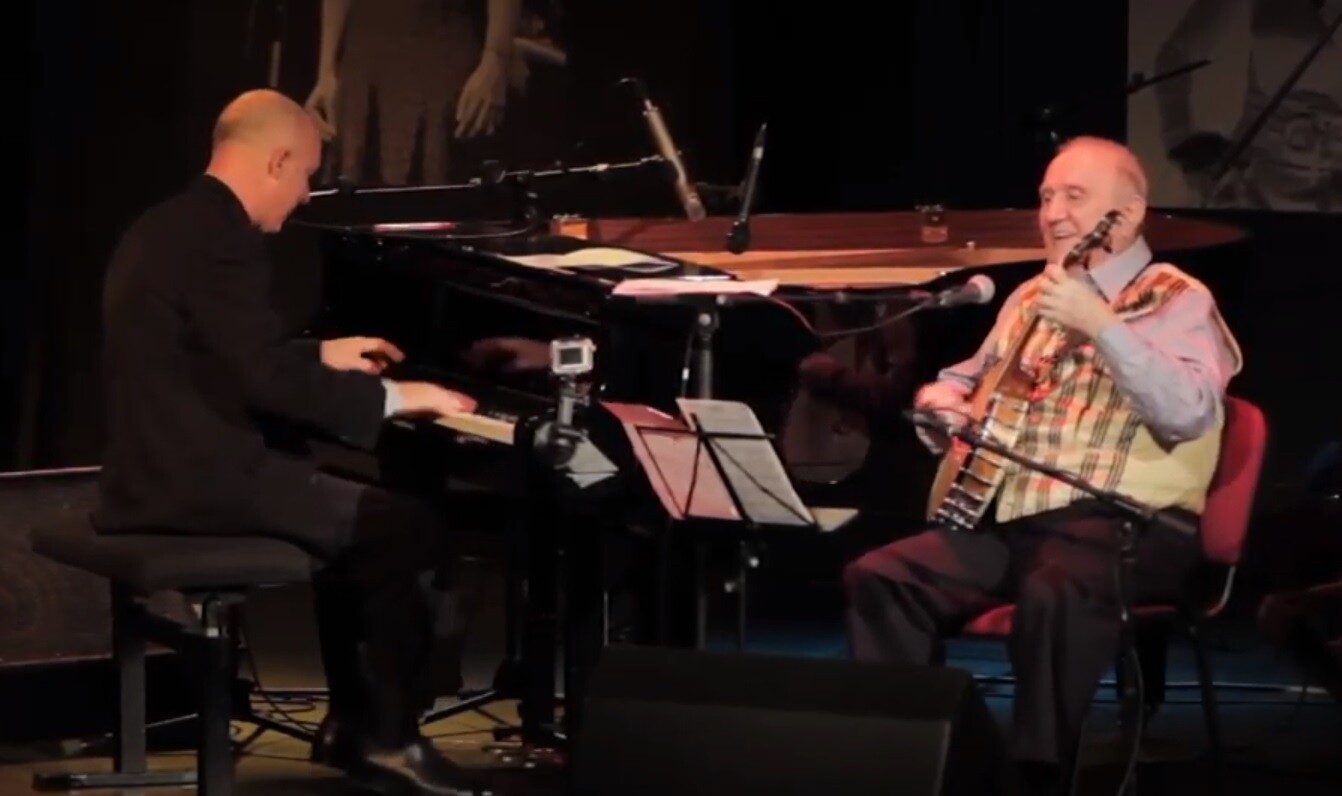Grammy winning pianist, double-bassist, vocalist, arranger, and teacher Conal Fowkes is a master of multiple styles of jazz and Latin music. Having excelled in his classical studies at the Royal College of Music in London, he shifted his focus to jazz, performing at most of the premier concert halls and jazz venues throughout Europe.
Fowkes moved to New York in 1996 and has performed throughout the US, with appearances on network television and in numerous motion pictures. He has been with the Woody Allen New Orleans Jazz Band since 2001. He is also a member of John Gill’s Yerba Buena Stompers, award winning Cuban group Los Soneros de Oriente, YeraSon Orquesta Charanga, Orquesta Tipica Novel, and Grammy nominated Latin group The New Swing Sextet. Schaen Fox recently interviewed Fowkes for TST:
What started you into music?
Quite simply my dad, a diehard jazz fan. We had jazz in the house every day. He played our beat-up old piano and got me started. The first thing that I really wanted to play, because he was playing it, was the “Swinging Shepherd Blues” Boogie Woogie style. Every time he played it, my brother and I got all excited and danced around. One day, he just showed me the left-hand Boogie Woogie part. My hands were too small to play it at the time, so I did it with a finger on each hand. I remember distinctly that it was one of the first major thrills of the piano for me and was probably enough to really get me into it.

So once my dad saw that I was really into it, he found me a classical piano teacher. Fast forward nine years, this teacher said, “I highly recommend you take up another instrument. Because you should broaden your experience with music.” I thought, “Well, I love listening to guys like Ray Brown. Why don’t I try a little Ray Brown?”
Now I’m about five foot four. Then I was probably about five foot one. One of the most unlikely instruments for a short kid is the enormous bass, but I really wanted to play it, and I started with a classical bass teacher. But, on the weekends with my dad, we formed a duo with my dad on piano and me on the bass playing all jazz, and standards. I still have the bass. I’m playing less and less these years, but it’s been in my life since I was about 15.
When you learn the piano as a kid, you spend your entire musical life alone, because it’s a solitary endeavor. When I took up the bass, it opened the door to, in my case, these orchestras where I was then with 80, to 100 other kids all in the orchestra. Then you form these friendships, and you all travel on the bus together, it’s a whole, much more enjoyable, life opens up. Though piano has always been my main instrument, the double bass may be responsible for me taking piano beyond high school, and it being my profession. If I’d have been stuck on my own, all those years, maybe I wouldn’t have stuck with it.
Did your classical teachers look down on your interest in jazz?
Absolutely, all of them did until I got to conservatory. I had just by luck, one of the finest piano teachers in London at the time, a man called Yonty Solomon, a great concert pianist. And he was a student of Myra Hess. Yonty was a jazz lover though he didn’t play it himself. He would get a little frustrated with me, because through four years of conservatory, I was more and more into playing jazz gigs. He was supportive, but he wanted me to get through his classical course.
When and how did you get to study with Chucho Valdez?
I moved to London in 1986, I met all kinds of musicians there. I played with a London based Latin Jazz Ensemble that played Afro Cuban Jazz, as well as Salsa music. The leader was Roberto Pla, a great percussionist who knew Chucho Valdez. Chucho would come to London about twice a year with his legendary band, Irakere, and play at Ronnie Scott’s Jazz club in Soho. On one of their visits, I went with Roberto, and he introduced me to Chucho and set up lessons.
I would go for my lessons in Ronnie Scott’s in the morning. There was usually somebody going around with a vacuum cleaner, and people at the bar washing glasses. I’d be sitting with Chucho at the piano. Lessons would go from an hour to two hours, then we’d take a little break and have an espresso across the street; then we’d come back and play some more. And this went on for two or three years, at least twice a year, whenever Chucho was in London. And he’d be there for a month at a time. That was an incredible experience.

Why did you decide to move to the United States?
It was kind of an accident. I came here for a two-week vacation; it was a visit to see a sculptor friend of mine who was living in Manhattan. I’d never been to the States before and I was completely blown away. There’s enthusiasm in New York that I didn’t find in London. There’s that sense of “can do, let’s try it, and go get them,” much more so than in the UK, which I don’t mean to put it down, but it’s more controlled there.
It was a life changing epiphany. I just thought this is absolutely the place I should be. I went home and London seemed much drabber compared with what I just saw. I wound things down in London and got on a plane without a job and with no musical contacts here. I just got started and figured it out.
How difficult was it to find your place in the city’s jazz community?
Emigrating anywhere is wrought with the obvious difficulties of arriving homeless and broke in a new country, without a network of people. That aside, I found New York musicians to be incredibly hospitable with open arms. Everywhere I went to see groups play, I was invited either to hang out with the musicians or sit in and play with them. Everyone seemed to ask for my business card, just a very positive response. I hadn’t found that in London, that seems to me at the time to be a New York thing.
In that respect, it moved much more quickly than I ever had imagined. It seemed, in a space of a few months, once I was able to get out and interact with musicians, things started to take off. It took me more than a year or so to be able to do that, because I had to get work visas, get a job, find accommodation, and all that kind of thing. So once I was able to get myself out there things fairly rapidly started moving.
What type of jazz were you playing at that time?
Primarily Dixieland, the reason being the first community of jazz musicians that I met, were centered around the Cajun in Chelsea. I was in Chelsea, by accident with a girlfriend. We walked around the city all day and were exhausted and starving. A sandwich board outside this place said to the effect “Cajun Food, and Live Jazz.” We went in, sat right at the front of the bandstand. The band was fantastic, particularly the guy playing the banjo. He was larger than life, playing all this fantastic music and singing. He clearly saw that I knew quite a lot of the songs. Then in the break, he came over to talk to us. If you knew Eddy Davis, that’s what he did all the time.

He said something to the effect “You guys are too young to know this old music. How come you know the tunes?” Much to my embarrassment and horror, my girlfriend at the time said, “Oh, he plays piano. You should let him play with you.” Eddy responded, “Great, come and sit in.” I nervously and reluctantly went up, and he set me up at the piano, put a mic next to me, and promptly walked away with the rest of the band to go and eat; leaving me to play the intermission. I probably played 15 to 20 minutes. Then the band came back, and Eddy said, “Stay and play a couple of tunes with us.” That was the beginning of a 25-year relationship with Eddy Davis till the day he died.
How did you get into Woody Allen’s band?
After that initial meeting, Eddy hired me to play bass in his band that played every Wednesday at the Cajun. We had steady Wednesdays for a couple of years, then he asked if I would sub on this Monday night gig that he had. I said, “Sure,” not knowing what I was getting into, but it was Eddy, my buddy, and how bad could it be? He gave me the address, and here I am at the Cafe Carlyle, and it’s the Woody Allen band. I had no pre-knowledge of the repertoire. And I’m glad I didn’t because I probably would have been a nervous wreck. Instead, I just showed up, and it all just happened. Vince Giordano was subbing on drums. I knew Vince so there were these friendly faces in the band, and we had a fantastic night. It was an absolute thrill.
Not long after that, the regular bass player, Greg Cohen was always subbing out the Monday night. Eddy said, Look, let me give Conal the regular chair, and Greg will be the sub and do the tour. That’s when I became a fully-fledged member of the band, still on bass. Fast forward some years, Cynthia Sayer who was the pianist, left the band. Woody had heard me play the piano. He said, “We should have Conal on piano, and get another bass player.” So, I moved to piano. I’ve been doing that gig for more than 20 years.
Do you have any career souvenirs in your home that visitors can see?
Yes, I have some framed pictures of me with various musicians, a poster of my only Broadway experience, One Mo’ Time, signed by the cast and the band, and my Grammy. I’m on the Midnight in Paris soundtrack. I played the piano and was the singing voice of Cole Porter in the movie. I guess, a quarter of the tracks on the soundtrack are mine. It won “Best Compilation Soundtrack for Visual Needs,” the official name of the award. They sent a nice plaque which hangs on my wall.
I also have some concert tour posters from Woody Allen tours and other stuff in filing cabinets or on shelves like sheet music, and signed copies of books. I inherited a whole crate of Cootie Williams recordings, signed LPs and things like that because my immigration lawyer worked for the Duke Ellington estate. She then passed away and left it to me.
Were those Cootie’s personal recordings of gigs?
They are unreleased, one-sided pressings on not even 78s. They’re a weird size and they’ve got the original studio pencil scribble on them. They seem to be test pressings.
I was very good friends with Frank Driggs, who was a partner to Joan Peyser, an award-winning writer. One of her last books was a biography of George Gershwin. Frank had the world’s largest private collection of photographs of jazz musicians. He gave me sheet music, some photos and all kinds of stuff which I treasure. Joan gave me a signed copy of her Gershwin biography and put in her will that I would sing Gershwin at her funeral. I played “Love is Here to Stay,” which was an enormous honor coming from one of the leading biographers of Gershwin.
I became a very good friend of Jay Mc Shann, and we were working to do a recording together when Jay died. I have some beautiful photos of myself and Jay and things like that.
What was Jay like off the bandstand?
He was an absolute teddy bear of a guy. He had this high pitch, soft voice full of all swing and blues, and that was just in his speaking voice. I only knew him for a few years, and he was just a wonderful kind of sweet, gentle man.
Thank you so much. I’ve been grinning for this entire hour.
Thanks, Schaen. I enjoyed it too.
Visit Conal Fowkes online at conalfowkes.com.
Schaen Fox is a longtime jazz fan. Now retired, he devotes much of his time to the music. Write him at foxyren41@gmail.com.





















